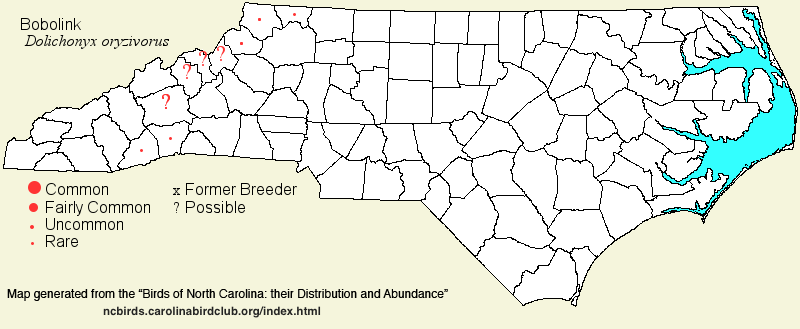 |  |
|
Bobolink - Dolichonyx oryzivorus ICTERIDAE Members: | Search Common: Search Scientific: |
|
|
|||||||
| General Comments | The Bobolink is in a monotypic genus, with no close relatives among the other icterids (blackbirds and allies). It nests across most of southern Canada and the northern United States, and in recent decades has started to nest in the mountains of North Carolina, despite a global decline in its population. (Most grassland nesting species are declining in North America, owing to loss of habitat to development.) Bobolinks travel in flocks in both spring and fall migration, which occurs across all of North Carolina. In spring, the males move north first, in same-sex flocks, and then the females follow a week later. In fall, they can occur in much larger flocks, of over 100 birds, and at that season the males have lost their gaudy breeding plumage. In summer in North Carolina, Bobolinks nest in somewhat extensive meadows, typically with no woody vegetation; these meadows are often mowed once or twice in summer, and thus some contact with the owners of the meadows by conservationists might be critical to maintain the small nesting population in the state. In migration, Bobolinks also are found in meadows, fields, and other tall grasslands; alfalfa fields are favored sites on spring migration. In fall, the birds are more inclined to occur in wetter fields and some fresh to slightly brackish marshes. There are a few winter reports (such as on CBC's), which may well represent mis-identifications; the species winters in South America. | ||||||
| Breeding Status | Breeder | ||||||
| NC BRC List | Definitive | ||||||
| State Status | SR | ||||||
| U.S. Status | |||||||
| State Rank | S1B | ||||||
| Global Rank | G5 | ||||||
| Coastal Plain | Transient. In spring, uncommon to occasionally fairly common in the western portions, but generally uncommon over the region. In fall, more numerous, and generally fairly common over the region; at times, common to occasionally very common along and near the coast. Mainly late Apr to late May, and mid-Aug to late Oct. Despite the fairly late date in fall for departing birds, there are no winter (Dec or later) records. Peak counts: 12,100, Alligator River NWR (Dare), 11 Sep 2015; 8,000, Oregon Inlet, 28 Sep 1985; 3,700, Mattamuskeet NWR, 26 Aug 2016; 3,000, North River Farms (Carteret), 6 Sep 2009; 2,100, Alligator River NWR, 2-3 Sep 2011. | ||||||
| Piedmont | Transient, and accidental nester. In spring, fairly common over the region. In fall, less common than in spring, and generally uncommon across the region. Nested at North Wilkesboro (Wilkes) in 1959; adults and two young were observed. Mainly mid- or late Apr to late May, and mid-Aug to mid-Oct. One seen on the Gastonia CBC (Gaston) on 14 Dec 2019* might be a first believable winter record for the region. Peak counts: 535, Mid-Pines Road area (Wake), 5 May 2023. | ||||||
| Mountains | Sparse summer resident, and transient. In summer, very rare and local (though nests persistently at a few sites, as long as the habitat is suitable), mainly in the northern counties (south to Watauga); casual and sporadic nester farther south, so far only known from Transylvania and likely Henderson; generally at elevations from about 2,500 to 3,500 feet. Elsewhere, generally uncommon in spring, and rare to uncommon in fall. Mainly late Apr to mid-Oct. Peak counts: in the breeding season, 30 near Beech Mountain in western Watauga, 6 Jul 2021; 20 at Glendale Springs (Ashe), 6 Jun 1999; 18 along Island Ford Road (Transylvania), 19 Jun 2020. | ||||||
| Finding Tips |
If one knows where the specific nesting meadows are in the mountains, it might be readily found. Otherwise, the best bets are in late Aug or Sep near the coast, where there are extensive fields, damp grasslands, and marshes. The extensive fields at Alligator River NWR are perhaps as good a site as any in the fall. ** to *** | ||||||
| Attribution | LeGrand[2023-08-10], LeGrand[2023-04-02], LeGrand[2021-11-07] | ||||||
| NC Map Map depicts all counties with a report (transient or resident) for the species. | Click on county for list of all known species. |
| NC Breeding Season Map Map depicts assumed breeding season abundance for the species. |  |